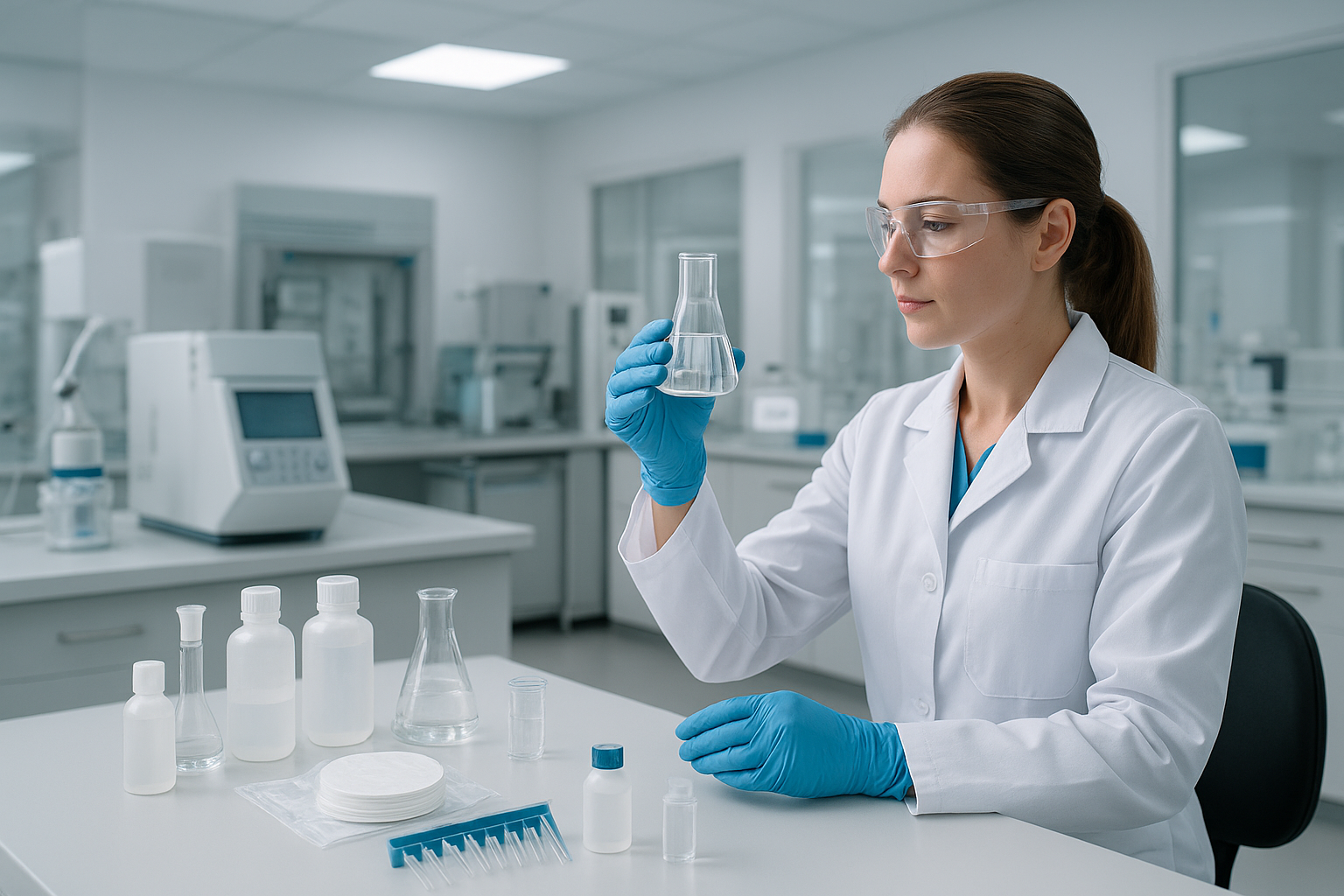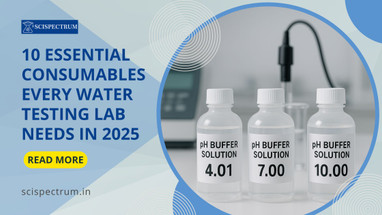Posted by Scispectrum on 24th Nov 2025
10 Essential Consumables for Water Testing Labs in 2025
Your complete guide to must-have consumables for accurate, reliable, and compliant water analysis.
In 2025, water quality monitoring is more important than ever. With rising industrial activities, stricter environmental regulations, and the demand for cleaner water, laboratories must rely on high-quality consumables to ensure accurate and reliable test results.
Whether you run an environmental lab, wastewater testing facility, or industrial water analysis setup, the right consumables directly impact your test accuracy, efficiency, and compliance.
Here are the 10 essential consumables every water testing lab must have in 2025.

1. pH Buffer Solutions (4.01, 7.00, 10.00)
Accurate pH measurements start with proper calibration. pH buffer solutions at 4.01, 7.00, and 10.00 are the core reference points for any pH meter.
Why Calibration Is Essential
- Ensures reliable readings in drinking water, wastewater, and industrial effluent testing.
- Compensates for electrode drift and aging.
Frequency of Replacement
- Fresh calibration before every testing session.
- Replace opened buffers every 30–60 days for best accuracy.
These buffers are must-have water testing consumables for all laboratories.
2. Conductivity & TDS Calibration Standards
Electroconductivity (EC) and Total Dissolved Solids (TDS) meters require regular calibration using certified conductivity standards.
Common Calibration Values
- 84 µS
- 1413 µS
- 12.88 mS
- 111.8 mS
Why Accuracy Matters
Accurate EC/TDS measurements are critical for assessing:
- Salinity levels
- Industrial effluent quality
- Drinking water mineral levels
High-quality standards help ensure essential water quality testing supplies 2025 remain compliant and dependable.
3. ORP (Redox) Calibration Solutions
ORP meters play a key role in processes involving oxidation and disinfection.
Importance
- Helps maintain correct chlorine levels in drinking water systems.
- Critical for wastewater treatment aeration and oxidation processes.
- Ensures stable electrode performance.
Certified ORP calibration solutions ensure precise redox potential readings for both field and laboratory applications.
4. Dissolved Oxygen (DO) Membrane Caps & Electrolyte Solution
Dissolved oxygen sensors need routine maintenance to ensure reliable results.
Why They’re Essential
- DO membranes degrade over time and affect response time.
- Electrolyte solution must be replenished for stable sensor output.
Common Applications
- Aquaculture monitoring
- Environmental labs
- Wastewater treatment plants
These consumables are considered foundational environmental testing lab consumables in 2025.
5. Turbidity Calibration Standards (0, 20, 100, 800 NTU)
Turbidity measurement is a core requirement for drinking water and industrial discharge compliance.
Uses
- Calibration of turbidity meters and nephelometers
- Verifying instrument performance
- Meeting BIS, EPA, and ISO reporting requirements
Standards like 0, 20, 100, and 800 NTU help maintain the accuracy required for sensitive turbidity measurements.
6. Nitrate & Ammonia Ion Calibration Standards
Ion-selective electrodes (ISE) require accurate calibration for precise ion concentration measurement.
Why They’re Important
- Ensure reliable detection of nitrate, ammonia, and other ions.
- Essential for environmental monitoring, groundwater testing, and agricultural runoff studies.
These ion calibration standards ensure consistent long-term performance of ISE sensors.
7. Laboratory Glassware & Sample Containers
No water testing lab is complete without high-quality lab glassware and contamination-free sample containers.
Common Items
- BOD bottles
- COD vials
- Beakers, test tubes
- Certified sampling bottles
Why They Matter
Clean, properly graded glassware prevents contamination that could alter chemical or microbiological results.
8. Filtration Consumables (Membrane & Syringe Filters)
Filtration is essential for sample preparation before testing.
Popular Options
- 0.45 µm membrane filters for general water testing
- 0.22 µm filters for microbiology or fine particulate removal
- Syringe filters for quick field or lab filtration
These filtration consumables help maintain clarity, accuracy, and instrument protection.
9. Reagent Tablets & Powder Pillows
Widely used in field testing kits and portable photometers.
Application Areas
- Chlorine testing
- Hardness
- Alkalinity
- Nitrite & nitrate
- Iron
Reagent tablets and powder pillows provide convenience, accuracy, and long shelf life, making them indispensable water quality testing supplies.
10. Disposable Gloves, Pipette Tips & Cleaning Accessories
To maintain hygiene and avoid cross-contamination, every water testing lab needs reliable lab safety consumables.
Key Items
- Nitrile or latex disposable gloves
- Pipette tips
- Microfiber cloths
- Lab wipes
- Cleaning solutions and brushes
These consumables help ensure safe and error-free workflows.
Why These Consumables Are Critical in 2025
The importance of using the best consumables for water testing labs cannot be overstated, especially as we advance into 2025.
- Ensuring NABL/ISO Compliance: High-quality, certified consumables are a cornerstone of accreditation, providing the necessary traceability and reliability for audit trails.
- Maintaining Accuracy of Instruments: Calibration with proper standards and the use of compatible accessories safeguard the precision of your expensive analytical equipment.
- Reducing Test Errors: By minimizing contamination and ensuring precise measurements, quality consumables significantly reduce the margin of error in all analyses.
- Supporting New Environmental Regulations: As regulations evolve, the demand for highly accurate and consistent data grows, making top-tier essential water quality testing supplies 2025 a necessity.
Buying Guide: How to Choose the Right Water Testing Consumables
1. Choose Certified Standards
Look for NIST-traceable or ISO-certified calibration materials.
2. Check Shelf Life
Always verify expiration dates on:
- Buffers
- Standards
- Reagent tablets
3. Proper Storage
Keep consumables away from heat, light, and contamination sources.
4. Avoid Low-Grade Products
Cheap or expired consumables may lead to inaccurate results and failed audits.
Conclusion
Choosing the right consumables is crucial for accurate water testing results, smooth lab operations, and compliance with regulatory standards. In 2025, laboratories should prioritize quality, reliability, and compatibility with their instruments.
If your lab needs high-quality consumables, Scispectrum provides calibration standards, reagents, filters, and accessories from trusted brands.
Visit us: https://scispectrum.in/
For inquiries or bulk orders, our team is ready to help.

